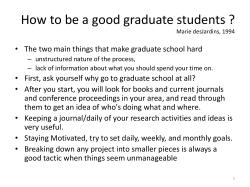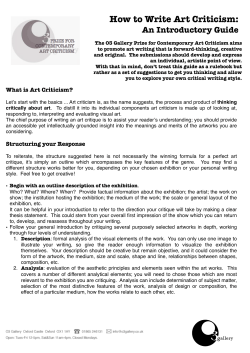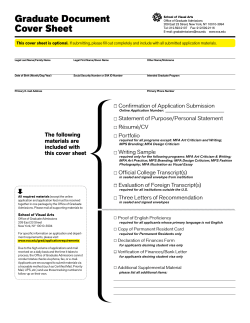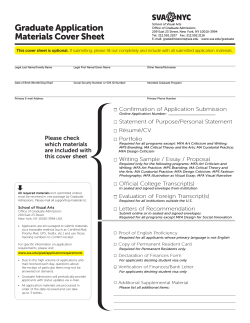
Rhetorical Criticism A Quick Introduction John A. Cagle …maybe not so quick
Rhetorical Criticism A Quick Introduction …maybe not so quick John A. Cagle Rhetorical Criticism Definitions • ....the systematic process of illuminating and evaluating products of human activity. • ....description, analysis, interpretation, and evaluation of persuasive uses of communication. • A communication critic seeks to make an argument that interprets or evaluates the messages to which the individual or society is exposed. Donald C. Bryant: Three things common to all criticism 1. the description of the object to be judged, 2. an exposition of and argument for the critical standard to be employed, and 3. a judgment made in terms of that standard. Definitions from Dann Pierce • • • The goal of popular critics is to express informed preference or “taste.” The goal of rhetorical critics is to advance knowledge about human communication that reaches audiences with public messages. Rhetorical critics are required to systematically explain and defend three things: 1. The necessity of their research, analysis, and criticism 2. The means or method of their analysis 3. The telling accuracy of their discoveries in analysis Pierce’s Acronyms • JFS: Justification for Study • JFA: Justification for Artifact • RQ: Research Questions • Method Sonja Foss: things suitable for rhetorical analysis... • • • • • • • • speeches essays conversations poetry novels stories TV programs public demonstrations • • • • • • • • films and plays art architecture dress music dance advertisements furniture e.g., Dean & Benoit: Rhetorical Criticism Ballot Judging Criteria From the data gathered here, the following judging criteria emerge in competitive rhetorical criticism: • • • • • • • • • • • • • • • • 1. adequate delivery skills (conversationality, enthusiasm, appropriate movement and gestures, direct eye contact, etc.) 2. memorized speech (no manuscript) 3. creative and substantive introduction and conclusion 4. clear preview 5. appropriate transitions 6. adequate documentation 7. focus of study appropriate for time limits of speech 8. judicious use of available time 9. inclusion of specific illustrations from the artifact(s) studied 10. analysis balancing description and criticism 11. justification of artifact(s) selected for study 12. justification of critical methodology 13. clear explanation of methodology 14. concise but complete explanation of the historical context in which the artifact occurred 15. clear judgment of the rhetorical effects of the artifact(s) 16. discussion of the implications of the criticism e.g., Terry Barrett's Criticizing Art: Understanding the Contemporary Description: What do I see? ( feel, hear, smell, taste)? • Subject Matter: Does the artwork depict anything? If so, what? • Medium: What tools, materials, or processes did the art maker use? • Form: What elements did the maker choose and how did the maker organize the elements? Interpretation: What is the artwork about? • Interpretive Statement: Can I express what I think the artwork is about in one sentence? • Evidence: What evidence inside or outside the artwork supports my interpretation? Judgment: Is it a good artwork? • Criteria: What criteria do I think are most appropriate for judging the artwork? • Evidence: What evidence inside or outside the artwork relates to each criterion? • Judgment: Based on the criteria and evidence, what is my judgment about the quality of the artwork? About Art Criticism: Sally Jackson on a blog • Judgment is formed on a basis of one's own background in the medium under consideration. I have no way of judging whether a piece of oriental brush lettering is brilliant or ugly. I know virtually nothing about it and have no basis upon which to form a judgment. On the other hand, I know a great deal about calligraphy and illumination. This is the result of many, many years of study and work and training in the field. I have, therefore, a valuable resource to draw upon and a basis upon which to form a judgement as to the skill or lack thereof exhibited in a calligraphy work. I am competent to make a judgment in this area. There are juried exhibits, and the jurors are those who have a background in the field they are judging. • I suppose the thing that springs to mind here is the trite saying, "I don't know anything about art, but I know what I like." Everybody does. There is a generally agreed upon perception of what constitutes beauty, and this probably changes from one culture to another. Even the Impressionists, so beloved today, were reviled when the movement was new. Caravaggio, Beethoven, Rembrandt, Bach, the Pucelle Brothers, van der Goes, Michaelangelo, The Master of Mary of Burgundy, Mozart, and on and on - most of us would agree that what they created was beautiful. I can't say what the standard is for art in general comes from. I simply don't know. I know the basis for my standards of beauty in my own field, and I could tell you what they are. This is a narrow field, though, and you raised the question of art in general. Television Criticism [James A. Brown] Prerequisites for proper critical perspective outlined by Lawrence Laurent three decades ago remain apt today: • sensitivity and reasoned judgment, • a renaissance knowledge, • coupled with exposure to a broad range of art, culture, technology, business, law, economics, ethics, and social studies • all fused with an incisive writing style causing commentary to leap off the page into the reader's consciousness, possibly influencing their TV behavior as viewers or as professional practitioners. http://www.museum.tv/archives/etv/T/htmlT/televisioncr/televisioncr.htm Functions of Criticism • Criticism helps to clarify and define the theoretical basis of public address. • Criticism helps to set up a standard of excellence. • Criticism helps to interpret the function of oral communication in society. • Criticism indicates the limits of present knowledge in the field of public speaking. Variables of Criticism • • • • • Source Message Audience and Environment Critic Foci: S-M, M-E, M-C, S-M-E, S-M-C, etc. Judgmental Criteria • • • • • Rhetorical effect. Rhetorical artistry. Ethicality or morality. Fittingness or propriety. Rhetorical competency. Objectivist Perspective • Accurate interpretation • Formal criticism • Neoclassical criticism “common standards of accuracy, beauty, or effectiveness are used to assess the manifest features of messages” Deconstructionist Perspective • • • • • Semiotics Value analysis Narrative criticism Psychoanalytic criticism Ideological criticism “attempt to probe the implicit features of messages and understand the ways in which those features govern human experience” What is a message? Major interpretations of message • • • • • • • • • meaning is in the conventions of language in the author’s conscious intent in the author’s conscious and unconscious intent what the best critics see in the text what the author’s contemporaries would have seen in the text what a receiver sees in the text what an “ideal” receiver would see relationship of text to society from which it comes contemporary society and text Kinds of Textual Data • • • • • • • • • Themes Attributions Subject matter Probable cause Stylistic features--syntax, figures of speech Values, attitudes, beliefs Argumentative features Intentions Political relations Hugh Blair (1783) • True criticism is the application of taste and good sense to the several fine arts. • The object which it proposes is, to distinguish what is beautiful and what is faulty in every performance; from particular instances to ascend to general principles; and so to form rules or conclusions concerning the several kinds of beauty in works of genius. Blair on rules of criticism • The rules of criticism are not formed by any induction a priori. . . • Criticism is an art founded wholly on experience. • Aristotle’s rules . . . were founded upon observing the superior pleasure which we receive from the relation of an action which is one and entire, beyond what we receive from the relation of scattered and unconnected facts. Blair on taste and genius • Taste consists in the power of judging; genius in the power of executing. • Genius is that talent or aptitude which we receive from nature, for excelling in any one thing whatever. Blair on the sublime • The true sense of sublime writing, undoubtedly, is such a description of objects, or exhibition of sentiments, which are in themselves of a sublime nature as shall give us strong impressions of them. • The foundation of it must always be laid in the nature of the object described. • But it must be laid before us in such a light as is most proper to give us a clear and full impression of it; it must be described with strengths, with conciseness, and simplicity. Herbert Wichelns (1925) • Literary criticism is concerned with evaluating the wisdom, beauty, and truth contained in great works of fiction, while rhetorical criticism is devoted to assessing the persuasive effect of situated oratory. • Rhetorical criticism focuses on discovering and appreciating how speakers adapt their ideas to particular audiences. Ernest J. Wrage (1947) • Rhetorical criticism can make important contributions to social and intellectual history. • Ideas are produced by historical contexts, are linked to change, and have social consequences. • Ideas, values, and beliefs of a culture are expressed in speeches. Wayland Maxfield Parrish (1954) • Critics should evaluate the quality of a speech. • The effect of a speech is difficult to assess, but the quality can be determined separately from its actual impact on an audience. • ...relying on the judgment of qualified critics, rather than trying to compute audience reactions. Preliminary Aspects of Criticism • Determining the areas of investigation • Establishing the authenticity of texts • Reconstructing the social settings Neoclassical Analysis • • • • • • • Finding issues Understanding the audience Discovering the structure Identifying arguments Values Ethos Style Organizing the Neoclassical Criticism • • • • • • • • Rhetorical situation Nature of the audience Structure of the message Forms of argument Values Ethos Style and delivery Assessment of effectiveness Standards of Judgment • • • • • • • Integrity of ideas: logical proof Emotion in speech: pathetic proof Character of the speaker: ethical proof Structure of oral discourse Style of public address Delivery Measures of effectiveness Bases for Judging Effectiveness • • • • • Readability Artistic superiority Integrity and social utility Immediate surface response Orator’s wisdom • Effect on subsequent events Insightful synthesis • Thonssen and Baird wrote, “Insightful synthesis integrates the many parts and makes the seemingly discrete components a whole piece.”
© Copyright 2025













